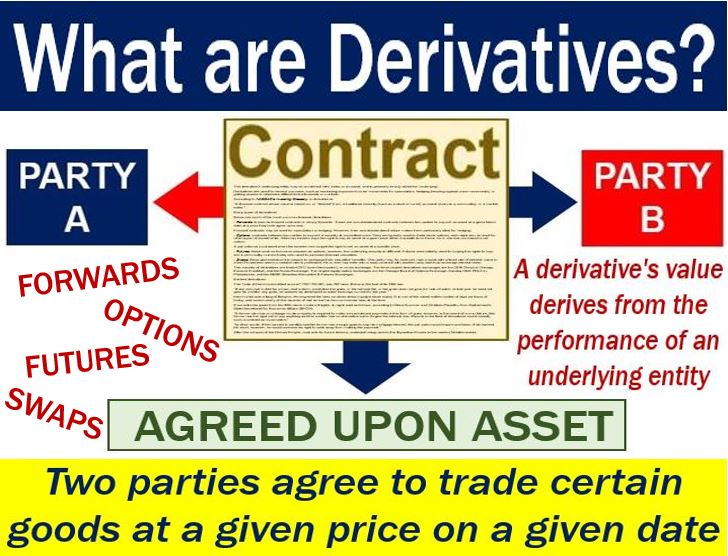Derivatives are contracts whose values come from the performance of underlying entities. Derivatives are securities that we link to other securities such as bonds or stocks. We might also link them to currency exchange rates and real estate.
Their primary security gives derivatives their value. In other words, they are not worth anything in and of themselves.
The derivative’s underlying entity may be an interest rate, index, or an asset. Investors usually refer to it as simply the ‘underlying.’
We use derivatives for several purposes, such as increasing exposure to price movements for speculation. We also use them for hedging or getting access to otherwise difficult-to-trade assets or markets. Hedging means protecting against price movements.

According to NASDAQ’s Investing Glossary, a derivative is:
“A financial contract whose value is based on, or ‘derived’ from, a traditional security (such as a stock or bond), an asset (such as a commodity), or a market index.”
A market index consists of numbers that represent weighted values of the components that make up the index.
Many types of derivatives
Below are some of the most common financial derivatives:
Forwards
We refer to them as ‘forward contracts’ or simply ‘forwards.’ These are non-standardized contracts between two parties to buy-sell an asset at a specific future date. The parties both agree upon a price now.
We may use forward contracts for speculation or hedging. However, most investors use them for hedging.
Options
Options are contracts between two parties to buy-sell a security at a specific price. We typically use them to trade stock options. Some people use them for other types of investments.
When investors buy the right to purchase an asset at a price over a specific period, they have purchased a call option.
We buy a put option when the investor has bought the right to sell an asset at a specific price.
Futures
Futures work on the same principle as options. However, the underlying security is different. People initially used them for buying the rights to trade a commodity. However, today we use them to purchase financial securities.
Options and futures traders focus on the NYSE Arca Major Market Index, which consists of 20 blue-chip company stocks.
Swaps
This type of derivative gives investors the chance to exchange their securities’ benefits. One party may, for example, own a bond with a fixed rate of interest. However, it is in a line of business where a variable rate is preferable. That party may enter into a swap contract with another party and thus exchange interest rates.
Investors buy and sell derivatives OTC or on an exchange. OTC stands for over-the-counter.
The three largest derivatives exchanges are the CME Group in Chicago, Eurex in Frankfurt, and the Korea Exchange.
The largest equity options exchanges are the Chicago Board of Options Exchange, Nasdaq OMX PHLX in Philadelphia, and the BM&F (Brazilian Mercantile & Futures Exchange).
Derivatives – early history
The Code of Hammurabi (1792-1750 BC) has 282 laws. Below is the text of its 48th law:
“If anyone owe a debt for a loan, and a storm prostrates the grain, or the harvest fail, or the grain does not grow for lack of water; in that year he need not give his creditor any grain, he washes his debt-tablet in water and pays no rent for the year.”
Hammurabi was a king of Babylon. He engraved the laws on stone steles, i.e., upright stone slabs. It is one of the oldest written bodies of laws we know of today. The Code of Hammurabi covers nearly all the aspects of civil as well as two commercial laws at the time.
If we write the quote from the 48th law in modern English, it might read as follows, according to Steve Kummer and Christian Pauletto, from Switzerland’s State Secretariat for Economic Affairs (SECO):
“A farmer who has a mortgage on his property is required to make annual interest payments in the form of grain. However, in the event of a crop failure, this farmer has the right not to pay anything, and the creditor has no alternative but to forgive the interest due.”
“Experts in the field of derivatives would classify such a contract as a put option.”
“In other words: If the harvest is plentiful and the farmer has enough grain to pay his mortgage interest, the put option would expire worthless. If his harvest fell short, however, he would exercise his right to walk away from making the payment.”
After the collapse of the Roman Empire, contracts for future delivery continued in the Byzantine Empire in the eastern Mediterranean.
From Mesopotamia to Europe
Sephardic Jews carried derivative trading from Mesopotamia to Spain during Roman times and the first millennium AD. Mesopotamia is a region in modern-day Iraq, Syria, and Kuwait.
After the Sephardic Jews escaped from Spain, they took derivative trading to the Low Countries in the 16th century.
Trading on securities subsequently spread to England and France at the turn of the 17th to 18th century. In the early 19th century, it spread from France to Germany.
Ernst Juerg Weber says that bankers were at the forefront of derivative trading during the 18th and 19th centuries. Dr. Weber is a Senior Honorary Research Fellow at the The University of Western Australia.
Dr. Weber adds that modern textbooks frequently misrepresent the history of derivative securities. Many books say that derivatives became significant only during the last twenty-five years. This is not the case; they have been significant for considerably longer.
Derivative – non-financial meanings
The concept of a derivative is at the core of modern mathematics and Calculus.
In linguistics, it is a form of a word that comes from another form, as in: “Detestable is a derivative of detest.”
In chemistry, it can mean a substance that comes from another substance. For example, trichloromethane (chloroform) is a derivative of methane.
It can also mean originating from, as in “Charles Darwin’s work is derivative of the moral philosophers.”
